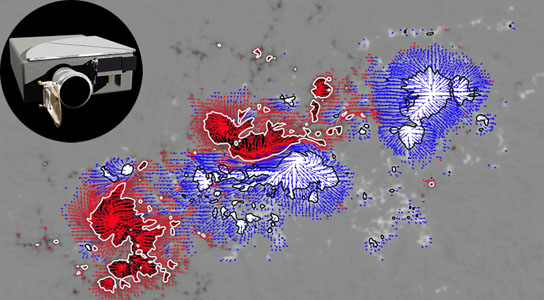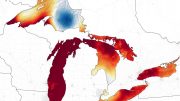
The Helioseismic and Magnetic Imager on the Solar Dynamics Observatory has been mapping the sun’s magnetic fields since 2010. Credit: NASA/SDO and the HMI science team
The Helioseismic and Magnetic Imager aboard the Solar Dynamics Observatory helps map the sun’s magnetic fields and has been gathering data since 2010. Recent vector magnetograms on the area of the sun named Active Region 11158 were released for researchers to examine to gain a better understanding of the strength and direction of magnetic fields on the solar surface and their effect on solar flares and coronal mass ejections.
A subset of data that helps map out the sun’s magnetic fields was recently released from the Solar Dynamics Observatory (SDO). Observations that measure the strength and direction of magnetic fields on the solar surface — known as vector magnetograms — play a crucial role in understanding how those fields change over time and trigger giant eruptions off the surface of the sun such as solar flares and coronal mass ejections (CMEs).
Collecting the information needed to make vector magnetograms is one of several tasks performed by SDO’s Helioseismic and Magnetic Imager (HMI), an instrument led by a team at Stanford University. HMI has been collecting data since May of 2010, providing scientific data on the strength of the sun’s magnetic field and the sound waves moving around inside the Sun.
HMI relies on interpreting the way light is affected as it travels through the fields in order to measure them from afar. For example, a phenomenon known as the Zeeman effect splits light into different wavelengths based on the magnetic field strength and, in addition, light may be polarized based on the magnetic field direction. HMI uses these observations to produce vector magnetograms. Producing vector magnetograms at HMI’s high resolution, however, required developing new computer processing techniques to successfully interpret subtle details about the magnetic field.
In early December, the HMI team released their vector magnetograms for one area of the sun, named Active Region 11158, collected during February 12-16, 2011. As a larger group of researchers examines the new data, the team can refine their computer processing algorithms if necessary and then release all the vector magnetic field data that HMI has collected.
This movie shows how magnetic fields evolved on the surface of the sun at an active region in February of 2011. The blue arrows show where magnetic fields rise up off the surface and the red arrows show the magnetic field lines returning to the surface.









Be the first to comment on "Solar Dynamics Observatory Measures Magnetic Fields on Sun’s Surface"